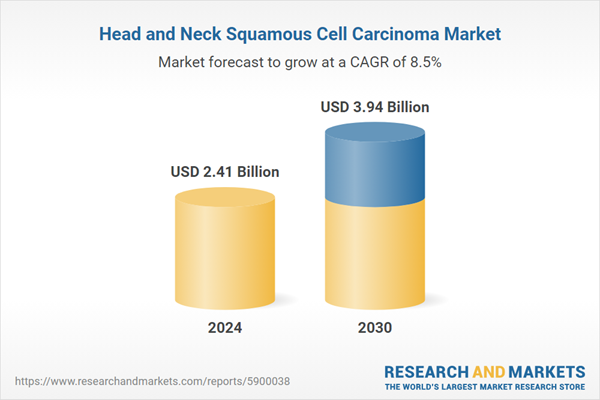Speak directly to the analyst to clarify any post sales queries you may have.
10% Free customizationThis report comes with 10% free customization, enabling you to add data that meets your specific business needs.
Rising cases of HNSCC, largely driven by factors such as tobacco and alcohol consumption, human papillomavirus (HPV) infections, and genetic predisposition, are fueling demand for innovative therapies. Pharmaceutical and biotechnology companies are intensifying research efforts to develop novel targeted therapies, including immune checkpoint inhibitors and monoclonal antibodies, to improve survival rates. The adoption of minimally invasive surgical techniques and robotic-assisted procedures is enhancing treatment precision, leading to better patient outcomes and reducing recovery time.
R&D investments and clinical trials focusing on personalized medicine and biomarker-driven treatment approaches are transforming the therapeutic landscape. Immunotherapy, particularly PD-1/PD-L1 inhibitors, is gaining traction as a preferred treatment option for advanced HNSCC due to its ability to enhance the immune system’s response against cancer cells. The development of combination therapies integrating chemotherapy, radiation, and immunotherapy is showing promising results in improving patient prognosis. The shift toward early detection through liquid biopsies and AI-driven diagnostics is expected to streamline patient management and optimize treatment selection, ultimately improving survival rates.
The market is also witnessing challenges, including the high cost of targeted therapies, limited awareness about early disease detection, and disparities in treatment accessibility across different healthcare settings. Resistance to existing therapies and adverse effects associated with certain treatments remain key hurdles in achieving optimal patient outcomes. Despite these challenges, opportunities exist in the form of expanding clinical research, government initiatives supporting cancer research, and an increasing focus on integrating AI and precision medicine in oncology. Strategic collaborations between biopharmaceutical firms, regulatory agencies, and research institutions will play a crucial role in shaping the future of the HNSCC treatment landscape, ensuring innovative therapies reach a broader patient population.
Key Market Drivers
Increasing Prevalence of Head and Neck Squamous Cell Carcinoma
The Global Head and Neck Squamous Cell Carcinoma (HNSCC) Market is experiencing significant growth, primarily due to the increasing prevalence of this devastating cancer worldwide. HNSCC has become a global health concern, affecting the mucous membranes of the head and neck, including the oral cavity, throat, and larynx. The surge in HNSCC cases is driven by several key factors, contributing to the expansion of the HNSCC market.One prominent factor behind the rising prevalence of HNSCC is the widespread consumption of tobacco and alcohol. These well-established risk factors have significantly contributed to the growing incidence of the disease, particularly among individuals with long-term or heavy use. According to the National Cancer Institute, the rate of new cases of oral cavity and pharynx cancer was 11.5 per 100,000 men and women per year, with a death rate of 2.6 per 100,000 men and women per year, based on data from 2017 to 2021. The synergistic effects of tobacco and alcohol increase susceptibility to HNSCC, emphasizing the need for effective treatments and interventions.
Another critical contributor to the increasing prevalence of HNSCC is human papillomavirus (HPV) infection. HPV-associated HNSCC cases have been on the rise, with the virus identified as a major risk factor for oropharyngeal cancers, a subset of HNSCC. The Centers for Disease Control and Prevention (CDC) reports that HPV is thought to cause 60% to 70% of oropharyngeal cancers in the United States. This growing recognition has led to heightened awareness, early detection efforts, and research into novel treatment strategies.
Additionally, changing lifestyle patterns and dietary habits have contributed to the rising incidence of HNSCC. Factors such as poor nutrition, exposure to environmental carcinogens, and genetic predisposition play roles in the disease's prevalence. As HNSCC cases continue to increase globally, there is an urgent need to address this healthcare challenge effectively. This urgency has spurred research efforts, innovations in diagnostics, development of targeted therapies, and exploration of immunotherapeutic interventions, aiming to improve patient outcomes and reduce the global burden of HNSCC.
Key Market Challenges
Limited Early Detection and Screening
Limited early detection and screening capabilities represent a significant hurdle in the advancement of the Global Head and Neck Squamous Cell Carcinoma (HNSCC) Market. HNSCC is a complex and often aggressive form of cancer that affects various anatomical regions in the head and neck, including the oral cavity, pharynx, and larynx. The lack of effective early detection methods poses substantial challenges in managing this disease.One of the primary reasons for the limited early detection of HNSCC is its asymptomatic nature in the initial stages. Unlike some other cancers that may manifest noticeable symptoms early on, HNSCC often develops silently, without obvious warning signs. This makes it difficult for both patients and healthcare providers to recognize the disease in its early, more treatable phases. By the time symptoms do appear, the cancer has often progressed to an advanced stage, reducing treatment options and compromising patient outcomes.
Moreover, HNSCC can occur in anatomical locations that are not easily visible or accessible during routine physical examinations. These cancers may develop deep within the throat or in the tonsils, making them less likely to be detected by routine check-ups. As a result, patients frequently present with advanced-stage HNSCC, requiring more aggressive treatments and experiencing a higher risk of recurrence.
Key Market Trends
Advances in Targeted Therapies
Advances in targeted therapies have emerged as a pivotal force propelling the growth of the Global Head and Neck Squamous Cell Carcinoma (HNSCC) Market. HNSCC is a complex and aggressive form of cancer that affects various regions within the head and neck, and traditional treatments often come with substantial side effects and limited efficacy. Targeted therapies have offered a more precise and effective approach to combating this disease.One of the key advantages of targeted therapies in HNSCC treatment is their ability to specifically target cancer cells while sparing healthy tissue. These therapies are designed to interfere with specific molecular pathways or proteins that play a crucial role in tumor growth and progression. For instance, cetuximab, an EGFR inhibitor, has been approved for HNSCC treatment. By blocking the epidermal growth factor receptor, cetuximab can inhibit the uncontrolled growth of cancer cells.
The development of targeted therapies is closely tied to our increasing understanding of the molecular biology of HNSCC. Researchers have identified specific genetic mutations and biomarkers associated with HNSCC, allowing for the development of therapies that are tailored to the individual characteristics of each patient's tumor. This personalized approach not only enhances treatment efficacy but also minimizes side effects, leading to improved patient outcomes and a better quality of life during and after treatment.
Key Market Players
- F. Hoffmann-La Roche Ltd.
- Boehringer Ingelheim International GmbH.
- GSK plc
- Novartis AG
- Bayer AG
- Merck & Co., Inc.
- AstraZeneca Plc
- Eli Lilly and Company
- Cipla Inc.
- Sanofi
Report Scope:
In this report, the Global Head and Neck Squamous Cell Carcinoma Market has been segmented into the following categories, in addition to the industry trends which have also been detailed below:Head and Neck Squamous Cell Carcinoma Market, By Type:
- Salivary Gland
- Oral and Oropharyngeal
- Nasal Cavity & Paranasal Sinuses
- Nasopharyngeal
- Laryngeal
- Hypo Pharyngeal
Head and Neck Squamous Cell Carcinoma Market, By Treatment:
- Radiation
- Chemotherapy
- Immunotherapy
Head and Neck Squamous Cell Carcinoma Market, By Route of Administration:
- Oral
- Intravenous
- Others
Head and Neck Squamous Cell Carcinoma Market, By End-user:
- Hospitals & Clinics
- Ambulatory Care Centers
- Others
Head and Neck Squamous Cell Carcinoma Market, By Region:
- North America
- United States
- Canada
- Mexico
- Europe
- France
- United Kingdom
- Italy
- Germany
- Spain
- Asia-Pacific
- China
- India
- Japan
- Australia
- South Korea
- South America
- Brazil
- Argentina
- Colombia
- Middle East & Africa
- South Africa
- Saudi Arabia
- UAE
Competitive Landscape
Company Profiles: Detailed analysis of the major companies present in the Global Head and Neck Squamous Cell Carcinoma Market.Available Customizations:
With the given market data, the publisher offers customizations according to a company's specific needs. The following customization options are available for the report.Company Information
- Detailed analysis and profiling of additional market players (up to five).
This product will be delivered within 1-3 business days.
Table of Contents
Companies Mentioned
- F. Hoffmann-La Roche Ltd.
- Boehringer Ingelheim International GmbH.
- GSK plc
- Novartis AG
- Bayer AG
- Merck & Co., Inc.
- AstraZeneca Plc
- Eli Lilly and Company
- Cipla Inc.
- Sanofi
Table Information
| Report Attribute | Details |
|---|---|
| No. of Pages | 184 |
| Published | March 2025 |
| Forecast Period | 2024 - 2030 |
| Estimated Market Value ( USD | $ 2.41 Billion |
| Forecasted Market Value ( USD | $ 3.94 Billion |
| Compound Annual Growth Rate | 8.5% |
| Regions Covered | Global |
| No. of Companies Mentioned | 10 |









